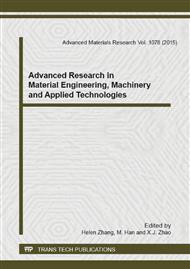p.70
p.74
p.78
p.82
p.86
p.90
p.94
p.98
p.102
Synthesis and Photochromism Studies of 1-(2-methyl-3-benzofuran)-2-[2-methyl-5-naphthyl-3-thienyl]perfluorocyclopentene
Abstract:
A novel photochromic diarylethene was synthesized and its photochromic and fluorescent properties were investigated. The results showed that this compound exhibited reversible photochromism, changing from colorless to amaranth after irradiation with UV light both in solution and PMMA amorphous film. In hexane, compound 1a exhibited an absorption peak at 266 nm, upon irradiation with 297 nm light, a new visible absorption band centered at 530 nm emerged while the original peak at 266 nm decreased. In PMMA amorphous film, diarylethene 1a also showed good photochromism as similar to that in solution. The photochromic reaction kinetics indicated that the cyclization processes of 1a belong to the zeroth order reaction and the cycloreversion process belong to the first order reaction. Diarylethene 1a also exhibited good fluorescent switching both in solution and in PMMA film upon alternating irradiation with UV and visible light.
Info:
Periodical:
Pages:
86-89
Citation:
Online since:
December 2014
Authors:
Keywords:
Price:
Сopyright:
© 2015 Trans Tech Publications Ltd. All Rights Reserved
Share:
Citation:


